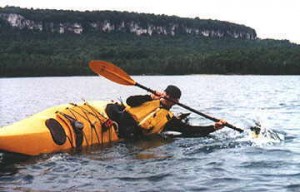Tim Dyer

High and low brace turns are my most favourite things to do in a kayak. Powerful, quietly carving, they have the potential to impress almost anyone, including your favourite person. Sea kayakers often get these turns confused with their whitewater cousins and the results are awkward, straining strokes ending in a hail of froth and splash, with about as much turn as a cow’s ankle. It’s all a boat dance really, and the whitewater crowd are short and quick to turn when you tell them to, but sea dancers, well … they are long-legged beauties who aren’t going to do anything just because you said so. So, let’s talk about how to make you and your sea partner dance and twirl.
First things first. If you are going to dance, you have to figure out who’s leading. Sometimes she (we’re talking boat here) wants to go one way and you the other. Somebody has to give in and the more you can agree, the better. Too many times I have lined up what I think is going to be a dandy carved turn, only to find my boat’s nose heading off in the totally wrong direction. This is usually a good time to give in and let her have her head, pretending you had it planned from the start. The trouble to get your way is usually not worth the effort.
But what is happening here? Well, the sea kayak world has somehow got this notion that if you edge left the boat will go right (a.k.a. outside turn), or something to that effect. It just ain’t so. All edging does is introduce a more curved and shortened wetted surface, which is more apt to turn. Sure there may be an argument that it will turn away from the edge, forgetting everything else – but when was the last time you successfully forgot “everything else?” The way it turns is completely a function of what forces are acting on the hull. When you add up those forces, one side wins out, and the winner is determined by a lot of things, including: how strong a stroke you have initiated the turn with, the shape of your hull, wave action and finally, the strength and direction of wind and current. Which brings me to my favourite strokes, both of which are inside edged turns, and a great deal of fun.
The high brace turn requires lots of forward momentum, so get a good head of steam going. Then start the proceedings with a couple of decent sweeps to the outside. Once things start to heat up and you think she’s got the idea, put her over on the inside edge, and hang a high brace (power side with slight climbing angle forward don’t forget!) right out from your hips at 3 or 9 o’clock and as far out as comfortable. The shaft should be approaching horizontal. Don’t overextend your arms, as you never know if she’s going to go all the way and you’ll need to catch her! Here is the best part. You just hang out on that high brace and wait for her to bring her head around. Don’t force the issue by drawing the blade forward, as you will simply stall her out. Just wait, and she will come. The turn is a wonderful dynamic feeling, and you can keep that feeling going by slowly bringing the blade forward of amidships to the bow as momentum slows. This keeps the turn happening and you might get another 10 degrees out of it. Once you’ve squeaked as much as you can, then it’s time to come upright again as you will have lost all bracing effect from the moving water. Finish off with a nice forward stroke and you both will look good. What’s really neat about this turn is the brace is simply there to allow you to heel her over as far as you can. It’s the action of the water against the hull that is creating the turn, not some heroic splash from your paddle. In fact, there should be very little noise or spray coming from your blade as that simply stalls out the turn and makes both of you look bad.
Now, on to the low brace turn. This has also been called a low telemark, and it has the same slinky smooth feeling as its high brother. It actually sets up and works the same way with lots of forward speed. The only difference is that we are now using a low brace presentation (non-power side with slight climbing angle forward) to the stern quarter at the 5 or 7 o’clock position. Again, we want to hang out for as long as possible (shaft near horizontal) and just wait for her to turn on edge. She’ll come round and when momentum slows, gradually bring the blade forward to midship position at 3 or 9 o’clock. Just like in the high brace turn, we are trying to wring out every last degree. Once you have wrung all you can, come on back upright, as you will have lost all bracing effect and there’s not much sense in tipping over! And there you have it, two fine dance moves for your favourite partner.
